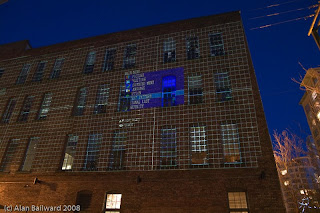The 7th annual Pentax World Global Shoot Day is coming up next weekend, where Pentaxians are encouraged to all shoot locally. Any Pentaxians from the Vancouver or Fraser Valley area feel like getting together?
Friday, October 2, 2009
K-7 Review @ DPReview
DPReview gives the K-7 a thorough, 33 page review and ends with.... well, I'll let you see the conclusions yourself. :)
Posted by Alan Bailward at 1:49 PM 2 comments
Monday, September 21, 2009
Fantastic Landscape Image
Sometimes you run across an image you have to give kudos to, and this is one of them. Lets see what's right about this lovely shot:
- Made with a Pentax (of course this has nothing to do with it....)
- Rule of thirds obeyed, boat is on the left third, horizon on the top third
- Foreground elements (boat + vegetation in the water)
- Triangles, lots of 'em, starting with the angled boat, extending to the mountains in the background, followed by vegetation on the bottom right and clouds in the background
- Center of focus on the sun, with everything pointing towards it
- Well lit and the perfect time of day, the golden hour rules!
Posted by Alan Bailward at 2:05 PM 3 comments
Wednesday, September 16, 2009
New Pentax K DSLR - The K-x
I'm realizing now that naming this blog after a particular camera body wasn't the smartest thing, especially now that the K-x has been released. OK1000 has some great details on it. Looks like it is basically a low end K-7 (with a $700-900 price point with lenses) and comes in funky colors. It has the picture mode stuff that the pros scoff at, has 12mp, ISO 100-12800, 720p video, HDR bracketing and a few other things from the K-7. This is to the K-7 what the *ist-DS was to the *ist-D, the lower end, affordable consumer model (not that there's anything wrong with that).
Posted by Alan Bailward at 9:14 PM 2 comments
Wednesday, August 12, 2009
What Resolution Is Needed?
I was having an IM conversation with a friend of mine today talking about the resolution of digital cameras and what's needed for printing images out, in his case for large wall hung landscape prints.
Posted by Alan Bailward at 10:29 AM 1 comments
Monday, August 10, 2009
BBC Series - The Genius of Photography - Is Genius
While I'm only about halfway through the 6 hour miniseries from the BBC The Genius of Photography, I have to say it's absolutely fantastic. Talking about photography and it's evolution from the very first images, though the renaissance of the new artists using it, to war and back again, it's done very, very well. Most of what hit me was how sometimes the simplest images have huge impact. Sure there are the "created" images, but some of the most powerful images that everyone has seen and knows (such as the iconic images from various wars) were just grabbed running and gunning with an all manual Leica, or shot as the photographer was thrown to the ground. No bitching about lens sharpness, or lack of bracketing, or having to go into the menus to get feature XYZ.... makes you think.
Posted by Alan Bailward at 11:04 AM 0 comments
Tuesday, June 23, 2009
Lightroom 2.4 and Camera Raw 5.4 Available
Lightroom Journal has the goods on the Lightroom 2.4 changes and improvements. Mostly minor bug fixes and new camera support (including K-7, whooho!).
Posted by Alan Bailward at 10:42 PM 1 comments
Labels: Lightroom
Friday, June 12, 2009
I Finally Start To Understand Flash and Pentax Wireless Flash Options
OK, it took a while, but I'm finally starting to really think I "get" flash, flash options, and the Pentax solutions that are out there. I pointed to this article on ok1000 last year, but thought that after the last 4 hours of hunching over a laptop with PDFs of flash and camera manuals open, a very ghetto "studio" (I started typing in "stupid" just then... ironic) setup with knickknacks as a subject I should write down a few things.
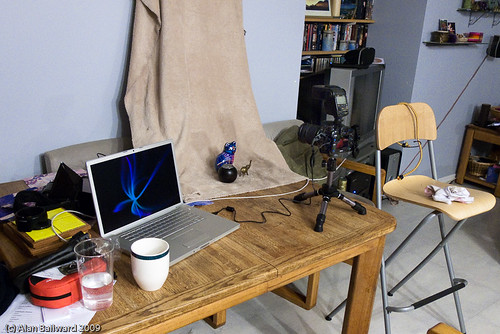
The setup I was using. Click through for notes.
Michael covered things really well in the OK1000 article, but sometimes you just have to do them yourself, by hand, with and without the manual to really get them in your head. Here's what I learned. Oh, first, equipment. The Pentax K20D of course, and the AF360FGZ flash unit, a laptop with USB cord for tethered shooting (more on that in a later post), and a big cup of tea (earl grey, hot) to keep me sane.
- The "SB" mode is really only useful if you want to keep the flash on the camera but not use it for anything other than a focusing aid. Seems useful to me only in situations where you're testing things and don't want to be yanking it on and off the camera a lot, or turning it on and off and on again.
- There are two wireless "slave" modes, 1 and 2. In mode 1 the flash works with Pentax equipment, in mode 2 it works as a triggered slave with non-Pentax gear. So if you're taking your 360 over to a friends house, and he has a Nikon setup and wants to use your flash, remotely triggering it with the flash output from his camera, you need slave mode 2.
- With wireless flash you will always need to fire the remotes with the built in pop-up flash (or another flash on the camera). There's a custom option (29) to set whether or not the output from the pop-up flash is used only for control of the remote flashes (set custom option 29 to off) or if you want it to be used for flash compensation, so both the pop-up and the remote flash contribute to the image (ie: a bit of fill in flash from the pop-up flash) (set custom option 29 to on).
- Some settings are done on the camera (slow sync speed mode) and some are done on the flash unit (first/second curtain). Some are confusing as well because the flash has a mode switch setting for first/second curtain, but under the flash options on the K20D there's also a second curtain mode. I believe the latter doesn't work with an external flash, only the on camera flash.
- Some functions are only available in some exposure modes. For example, high speed sync mode isn't available in the Av exposure mode, only Tv.
- Some functions will only show up in certain circumstances. For example, if you set your flash to the HS (High speed Sync) mode, the little "HS" in the LCD will only show up after you set your aperture past the sync speed of 1/180th.
- In some exposure modes with the Flash attached, one of the wheels suddenly starts controlling the ISO. If you're like me and always forget which the front wheel does and which the rear one does, keep an eye out for this!
- You can get very interesting using +/- EV for both the camera and the flash. IE: To raise the overall image light, set +EV on the camera, but then you can dial down the flash so it doesn't over power your subject. Or something like that. This is more a "when do I use what where" type of thing that I'm still working on.
So why would you use various flash modes and what affects what in them. First the easy ones.
Slow Sync Mode
Used when the backdrop is darker. Allows you to "drag the shutter" to let more light in so the background lights up as well as the "flashed" main subject. This is where you want to adjust first or second curtain settings.
Useful for images of moving objects with a sense of speed or motion to them. IE: a dancer frozen at the peak of a jump, but with blurred leading lines. Also good to play with for dimly lit areas. David Hobby of Strobist fame uses the term "burn in", which evokes a great image of the rest of the background slowly embedding itself onto the sensor, like using a spray paint can without moving it and waiting for what you're pointing it at to become solidly filled in.
High Speed Sync
The opposite of slow sync really. Used if you want faster shutter speeds than the 1/180th or 1/250th that your camera allows. Useful for things like freezing fast action without any leading blur. Also for adjusting how much of a shot is lit. If you want to photograph a person or baby or something and not have the background lit up, only the foreground, then this is where you play.
On the back of the 360 flash it shows a guide line of what distance your flash is being effective at, it'll shrink drastically if you start pusing the shutter speed to 1/1000 or higher.
First / Second Curtain
Classic example is a moving car. First curtain flash will freeze the car but have the blur "trail" moving forward, because the flash fires as soon as the shutter opens. Second curtain fires at the end, so your moving car would be a blur line moving to a frozen image.
Adjusting Your Aperture
This controls the ambient light. A larger f-stop number (ie: f/13) will let less ambient light in, so your background is going to be darker. A smaller f-stop number (ie: f-4.0) lets more background light in, so the background is lighter.
Adjusting Your Shutter Speed
This controls the main subject. Faster or slower shutter will give you different effects in terms of the high/slow speed sync as above.
Getting a Reading
I'm now treading way into "mostly guessing" territory. Lets say you want to light a subject in a not well lit room. My guess would be take a flash-less meter reading, and see what the exposure should be. Lets say 1/4 @ f/5.6. So that's the ambient exposure. Now you're adding a flash on, so you're exposure will be something like 1/180th @ f/5.6. This is where you pick click off this site and read this exercise on Strobist 102, where David makes way more sense than me.
In fact, now I have myself setup with a nicely reproducable system, I'm about ready to start going through the Strobist classes and not be fumbling around wondering why my flash isn't firing!
Thanks for reading this far folks!
Thursday, June 11, 2009
Lightroom Plugins
A few plugins for lightroom crossed my RSS reader today. Lightroom News has a bunch of them, everything from tweeting pics to shutterfly to backing up your config.
Posted by Alan Bailward at 9:02 PM 0 comments
Sunday, June 7, 2009
K7 HDR Mode
Some results from tests of the K7's HDR mode are up on the Adorama blog. Their conclusions....
The Pentax K-7 is a game changer. The era of in-camera HDR begins today.
Well, I won't lie and say that while I'm happy with my K20D, I'm itching to get my hands on a K7, just to see....
Posted by Alan Bailward at 11:29 PM 0 comments
Friday, June 5, 2009
Flowers!
Took these in a friend's back yard. I went out on a bit of a limb this time and used only my M50/1.7, non-autofocus only manual lens. Course, I still had my other lenses with me, but I wanted to do it by hand. Also in the past I've had some pretty horrible "green button" manual exposure setting with the K20D (I'm told the overexposure problem actually started on the K10D). Course, checking the histogram and LCD helped. I like the bokeh, but I do think I should have bumped it up a couple more stops to get more depth of field.
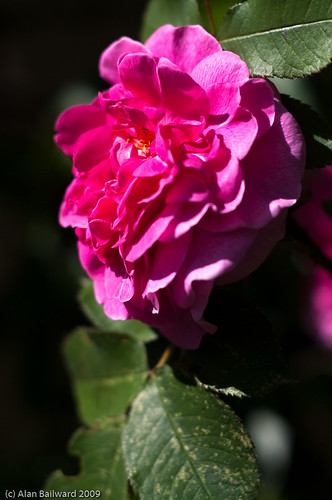

This last one is a sepia version of the red flower above, just some of me playing around with lightroom to get a different look.
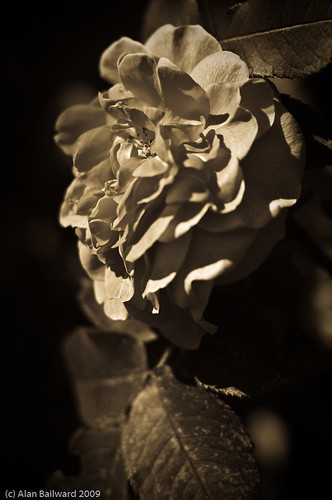
Thanks for reading!
Posted by Alan Bailward at 6:16 PM 0 comments
Saturday, May 30, 2009
Golden Ears Walk

Probably my favorite pic from a walk Friday out to Golden Ears park. This is a panorama stitched together with PTGui, which really did an incredible job, considering of the 4 images the person and dog (our friend Jesse and her dog Cheech) were in motion. Obviously a bunch of photoshopping involved, mostly in the conversion to black and white, playing with saturation and clarity settings. I just remembered I had a "Ansel Adams B&W" action from one of my Photoshop books that I should throw against this one and see what happens.
Posted by Alan Bailward at 6:38 PM 2 comments
Labels: Black and White
Wednesday, May 27, 2009
May Strobist "Newbie" Meetup
A couple of weeks ago a bunch of folks from the Vancouver Strobist group on Flickr got together to teach the newbies how to do strobist stuff, the art off off-camera lighting. The idea was to get a few experience folks as mentors, give them a small group of us green newbies, and teach what they could. The models model in exchange for pictures for the portfolios, which the photographers give them in exchange for models to create pictures for their portfolios. TFP is what it's called, Time For Pictures, Trade For Portfolio, etc.
Anyway, as one of the newbies, I had a great time and I just yesterday finally got around to processing a bunch of images, and after getting approval from the models, am ready to post a few here.
The first model we worked with was Jessti, with Glen (or Glenn?) as the mentor. His method was very exacting and precise, using a light meter, etc, and getting great results. I'll update with a pic from the session when the model gets back to me with approval to post them though.
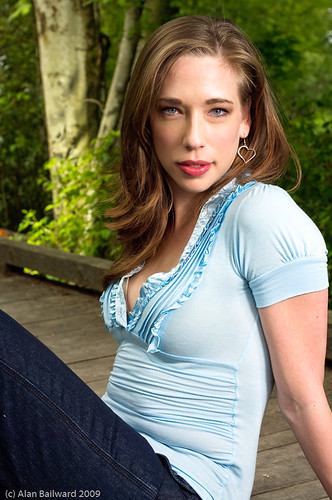
This is actually the second model we worked with, Maggie. To light her we set up a flash on tree in the background, a bare flash as key light hanging from a tree to her right, and shoot through umbrella to camera right (manned by a V.A.L.). This second setup was even a bit nicer as it was with Steve who lives not far from me and who does some awesome and funky shoots. The setup wasn't as extreme as some of his other portfolio, but it was a different way of doing things that was cool to see.
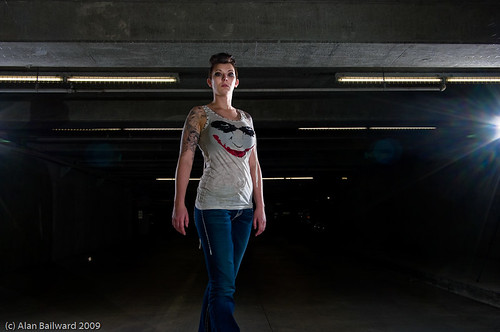
This one is from the end of the shoot, when everyone retired to the grass there was one group still going, and I jumped in and got a few shots of Cindy. Lighting her there are flashes behind on left and right and homemade straw grid spot to camera right.
End result was a great day, meeting lots of new people, and learning a lot from the group. Well, that and a sunburnt head :) The only disadvantage with these types of strobist meetups is that there are so many people who want to learn this stuff that the setups are more done by committee in a way, and there's not a lot of one-on-one work with just you and the gear and playing around. Could also be that I was just too scared to start messing with things with 3 other guys waiting to take pictures and a model who is sitting there all made up and waiting :)
Hardware wise there were a couple of things that were a bit off for me. The K20D has a max sync speed of 180th (vs the 250th that the newer Nikons have) which meant that when things were set up and people figured out the right settings, I had to adjust things to compensate. Also even when I did my exposure settings seemed way different than everyone elses, not even just moving an f-stop or two to compensate for the 180 vs 250, but some completely different stuff. Though time alone with equipment might show that it was more me than the Pentax gear that had the problem.
The last thing was this again cemented my desire for a 70-200/2.8 equivelant portrait lens like the big boys have. The DA* 50-135/2.8 would be perfect for those long shots with shallow depth of field. The 16-45 I use most of the time gives the wrong perspective if it's used in anything but the most zoomed position (67mm equiv) and the 70-300 I have is a) slow and b) too zoomy a lot of the time (150mm equiv at the most un-zoomiest).
Posted by Alan Bailward at 11:05 PM 0 comments
Saturday, May 23, 2009
Intensifying the Ocean
Found this fantastic tutorial on Intensifying the Ocean, via Brent Pearson's excellent site. I only wish I was closer to Australia so I could take one of his seascape photography courses :) Of similar note is an eBook on Night Photography and Light Painting that I'm considering picking up.
Posted by Alan Bailward at 1:29 PM 0 comments
Wednesday, May 20, 2009
Home Studio Conversion in Stop Motion
DIY Photography shows me once again why excuses like:
- "I can't do studio photography, I don't have a studio"
- "I don't have space to do a real studio"
- "It would take a huge amount of time and money to create a place to do studio photography"
The video is by James Burger and is funny, cute, neat, and inspiring, all in 108 seconds of stop motion.
Posted by Alan Bailward at 9:14 PM 0 comments
Tuesday, May 19, 2009
"The New K" Hits Tomorrow
Yup, tomorrow is the big day.... 1001 Noisy Cameras has a countdown blog, and I've seen lots of goodies posted here and there (mostly links from the dpreview Pentax forum), which indicate HD Video, a new sensor, new processing engine, and slightly smaller size than the K20D. I guess we'll see what happens tomorrow for Pentaxians. The places to watch would be the US Pentax site and the Japan Pentax site, though the countdown blog is live, so that's where I'll be watching.
Posted by Alan Bailward at 7:35 PM 0 comments
Labels: K7
Thursday, May 14, 2009
DHS Photography "License"
This is pretty funny, cool, and awesome, all at the same time. Matthew Williams has created two photographer license templates for presentation to the Department of Homeland Security and/or the San Francisco Municipal police (I think that's what Muni is for anyway). They are gorgeously designed and official looking (though I'm quite certain not actually accepted or recognized by any sort of official organization :) Still, fun looking to create your own and something to whip out next time you're being hassled by the man for taking pictures of docks, street signs, or (closer to home here in Vancouver) security cameras.
Posted by Alan Bailward at 6:57 PM 0 comments
Monday, May 11, 2009
Capturing Rain
Had a heck of a downpour here tonight... Ran out with my DA 16-45/4 and captured a few shots. The new firmware did well with the shake reduction, but sadly my skills at capturing the impression of rain and the power of the wind and water coming down were lacking. The only couple of shots that were half decent (and not from an artistic point of view) are below.


Time to look up other images of rain and weather and see how other, better photographers do it :)
Posted by Alan Bailward at 11:13 PM 1 comments
Thursday, May 7, 2009
Info (?) On the Newest Pentax FROM Pentax

Well, it's not much, and I'm not going to recap 1001 Noisy Cameras' multiple (and great) K7 news updates, but a reader in the forums noted that the Pentax Japan site was now a shadowed DSLR image. A translated page doesn't show much more, other than meeting places to watch the presentation on 5/21/2009.
I know there aren't many people watching this blog, but if the uber-camera all us Pentaxians are wanting (full frame, 10fps, no noise at ISO 6400, costs $20, etc), are you going to upgrade from your K20D/K200D/K2000D/K10D/etc? What'll be the killer feature that will get you to break out your checkbooks in this economy and get a new DSLR?
Update: Maybe it's just a time zone thing, but the US Pentax site has the "New K" date as 5/20/2009.
Posted by Alan Bailward at 10:11 PM 0 comments
Tuesday, April 28, 2009
In Praise of Hyper Program Mode
A really good article over at OK1000 about Hyper Program and Hyper Manual exposure modes.
Both these cameras [the Nikon D3 and the Canon 1D Mark III] fall down sorely when it comes to how the exposure modes are accessed. Pentax’s ingenuity here towers over them in this regard.I've been using the green button and hyperfocal mode since my first DSLR the *ist-D back in 2004 or so and am constantly shocked that other cameras don't let me have that control. A couple of friends of mine have Nikons and I'll put them into the P mode and start twiddling the thumb and finger dials only to find that whatever I think I'm doing, I'm really not!
The article linked above actually is just a reference (as this post is) to a description of what Neil from PlanetNeil.com thinks The Best Camera In The World would be. Lots of good stuff in there though :)
Posted by Alan Bailward at 10:38 PM 0 comments
Panorama Viewing Site
ViewAt is a site to let you organize, share, view, and geotag your panoramas. I love panos, though not that many of mine turn out that well. Check out this great example from False Creek, Vancouver, not all that far from where I am now. Gorgeous shot by Randy Kosek (more here).
I'm looking forward to more browsing of the site for more awesomeness.
Posted by Alan Bailward at 10:28 PM 0 comments
Friday, April 24, 2009
Pentax DA 15mm f/4 Review at DPReview
Title basically says it all... check the review here.
Posted by Alan Bailward at 10:17 AM 2 comments
Thursday, April 9, 2009
New K20D Firmware (1.03)
Via a bunch of places, but the quick and dirty details are over at OK1000, all about the new K20D firmware that's available. This is to make the shake reduction more accurate (sweet), but some in the forums have reported it seems to make the autofocus faster as well (sweet!).
Looking forward to updating and testing this tonight.
Posted by Alan Bailward at 3:45 PM 0 comments
Wednesday, April 8, 2009
Cloudy View

Posted by Alan Bailward at 11:33 PM 0 comments
Labels: Black and White, K20D
Sunday, April 5, 2009
Illuminate Yaletown 2009
After the Strobist meetup that I recently wrote about (immediately after actually) I headed to the "Illuminate Yaletown" celebration. This took place in (unsurprisingly) Yaletown, deep in the depths of Vancouver. Basically it was a two or three block area where various businesses had color-oriented displays setup. At one there were fire dancers, another illuminated a building wall with cool moving shapes and colors, one had ice sculptures with cool lighting in and around them, there was a band playing, there was a mini-dealership with strobing lights in and around the cars... All looking very cool.
It was actually nice because it didn't seem like a bunch of selling going alone with this. Mostly I'd expect these displays to be thin veils over companies pushing their wares on you, and while there were definitly companies associated with the different locations, it seemed like it was more about the displays and bringing people in the area together than about selling stuff. Some huge screens projected on buildings dominated the second half of the walk.



There were a lot of photographers there. The Vancouver photo group at meetup.com is the group I started out with, but in the dark, really it was a free for all, and there were tons of people with tripods and DSLRs milling all around. I ended up just wandering by myself for about an hour or so and then heading for the (long) drive home.

This is one case where I'd have loved a faster lens. The two that I took with me were my DA 16-45/4.0 and the DA 40/2.8 Limited. The shots (as you can see) weren't all that bad, though lots of steadying myself against buildings or railings was used, and ISO was generally 400-800. Combined with the shake reduction that really helped things. I am still lusting after the DA* 16-50/2.8 though. I switched to the 40 once, around the time where I hit the display with the band, but even wide open at 2.8 it didn't seem to help much somehow. Maybe because I chose a scene with energetic moving people it just seemed that way? It's an odd focal length though.... I love the fact that I have a "Limited", but the 40mm length translates to 60mm which is in that odd place between the "normal" view of the 50mm range and the so-called "portrait" 85-110mm length. Of course, it's not like there's no place for a 60mm lens (in 35mm terms), but it doesn't have the sweet spot that much lauded FA31/1.8 Limited or the FA77/1.8 Limited has.
As an aside, if anyone has a cool $1600 USD they have no need for, contact me cause there's a couple of lenses I want to talk to you about :)
Enough of that, more pics!

(Note that this has sat here in draft form for a couple of months now, my apologies for the lack of posting again)
Posted by Alan Bailward at 11:38 PM 1 comments
Thursday, March 19, 2009
Ads Against Photographers In Vancouver
Just a quick note to make people aware of some new Translink Ads in Vancouver in prepration for the Olympics. I had thought that we were safe up here from some of the paranoid, big-brother insanity that you hear about from south of the border, but it seems note. Please note that Jennifer from the Translink's blog, has commented and explained a bit of what was going on, but the issue still is (IMHO) that the ads say to the public "suspect photographers with DSLRs", and perpetuates the impression that photography could be bad/wrong/illegal. Lets be serious here, if you're a "bad guy" and you're doing surveillance, you're going to be doing your photography way less obviously.
Anyway, there's lots of good discussion in that forum thread. Time to break out the "Photography is not a crime" stickers?
Posted by Alan Bailward at 4:06 PM 0 comments
Labels: Olympics, PhotographyIsNotACrime, vancouver
Wednesday, March 11, 2009
PMA 2009 Wrapup
Well, I waited a few days after PMA finished (totally not because I got busy and lazy, definitely not...) just in case some some dark horse products appeared. Sadly no such luck.
DPReview had a nice wrap up of what was released, the two interesting products from Pentax are:
- The Pentax X70, a 24x super-zoom (26-624mm/2.8-5.0), 12 megapixel, multi-aspect ratio, 2.7" LCD, EVF, monster. I think it does RAW as well, but that doesn't seem to be on the page. Kinda cool, stepping in and stepping up to the realm of the Canon SX1-IS range (which my wife has and enjoys the zoomability of).
- The DA 15mm/4.0 Limited, another in the line up of Limited lenses. This is another one where I'm not sure if I'd get it as my main lens is the 16-45/4, and I'm not sure if that 1 extra millimeter, at the same f-stop, is worth the $500-600, even at the the optical quality of the Limited series. Unless of course you're specifically using only primes or only limited lenses of course. That's not to say that I wouldn't gladly evaluate this lens for the site :)
Oh well, maybe next year something new and exciting will appear! Until then, time to keep on shooting!
Posted by Alan Bailward at 2:18 PM 0 comments
Sunday, March 1, 2009
Pentax K30D Rumor Diary
Found out that 1001 Noisy Cameras has a K30D rumor diary. Reminder that PMA starts tomorrow, so fingers crossed for something good/revolutionary for us Pentaxians.
Posted by Alan Bailward at 9:48 PM 0 comments
Sunday, February 22, 2009
The Vancouver Strobist Beginner's Meetup
Saturday I was out with a bunch of other fine folks from the Vancouver Strobist group for the "Beginner meetup". This was organized by Rod, who got us use of the Life Sciences building out at UBC (and the building itself is gorgeous BTW).
The format of the meet was fairly loose. There were a couple of "pros" (not pro photogs, just people who know stuff about off camera lighting) who helped out the 12 or 13 newbies. Rod (who put the whole thing together, many thanks to him for this) gave a quick and dirty demo and then we newbies went to it.

The previous meet up I went to was more about the picture taking than the lighting itself, this one was way more focused on the lighting aspect and the equipment hands on. The hardest part for me was figuring out what I wanted to do. There were more than enough flash units, pocket wizards, radio poppers, umbrellas and stands for everyone there, but if you don't know what to do with them... I've seen great portraits, and I've seen pictures that have moved me, but under the gun I couldn't think of a single thing to do! Luckily there were a bunch of other people around who did have ideas, and eventually everyone fed off of everyone else.
Folks split off into a few groups of 3 or 4 people, rotating between acting as models (as the plan was for this not to be about the models, but about the lighting) and tweaking lighting, and taking shots. The group I was in was working on doing a "single umbrella giving a round halo behind the model" shot, some cross lighting, and some other setup. Everything from umbrellas to gels were played with, and I learned that if you set white balance for tungsten, and use a CTO (Color Temperature Orange I believe) gel on a flash, you get a super-blue environment and a properly colored skintone (as the CTO gel counteracts the blue tinge you get from the white balance). Another group working down in the hallway created some very cool images such as this one.
The lighting setups we used were pretty simple I'm sure, and the results no doubt laughable for an experienced Strobist or Joe McNally type, but for me it was pretty exciting to actually get my hands on the gear. Sure you can read about how you move an umbrella closer to get a softer light, or how to use fill flash or a reflector, but I find that when I actually do it is when I really get it (at least a little).
You can check out the Vancouver Strobist group on Flickr, and here's the thread of impressions and sample images from others. Thanks again to Rod and Victor for setting it up and helping us out.
Looking forward to the next meetup! Check out some of my shots below (clickable to Flickr where there's more setup info).

Dan who was a model for me a bunch, done in black and white to keep with the contrasty lighting.
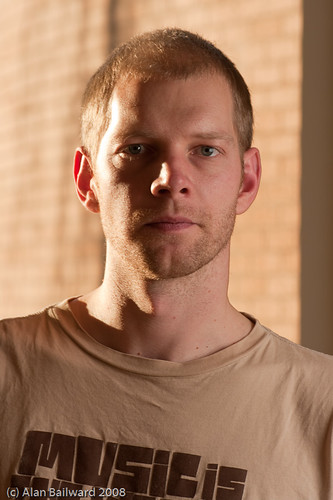
Music man (never got his name :( ) playing with cross lighting, using one flash and the sun setting behind him.
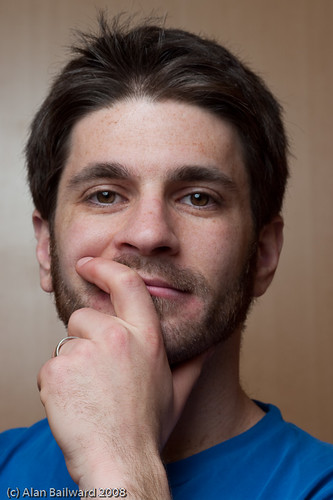
Dan again, more "normal" portrait, soft lighting.
Posted by Alan Bailward at 9:54 PM 0 comments
Using MTF Priority
Found this quick tip from topgun2007 on the Pentax SLR Forums on DPReview. He writes that using the MTF program line will let the camera (K10D and K20D) select the best aperture/shutter speed combination based on the camera's knowledge of the lens attached. Basically every lens has it's "sweet spot" programmed into the circuitry, and MTF allows the camera to prioratize for that sweet spot on lenses it knows (ie: DA, D FA, FA, or FA J).
To set this up on a K20D (or K10D or *ist-D) you need to do two things. First, go into your menu, select the custom functions tab, and it's the first option there: #1 - Program Line. In there are four settings:
- Normal
- High Speed
- Depth
- MTF
Second, you need to be shooting in "P" mode, or this won't come into effect. "P" mode is the Program mode from Pentax (and I can't believe that Canon or Nikon don't do this, at least on the cameras I have played around with) that allows you to set either the aperture or shutter speed, and the camera will adjust the other to match. Hitting the green button will reset to the default.
So for example if the default for a scene is 1/20th @ f/4.0, if you adjust the shutter speed two stops down, to 1/10th, the camera adjusts to f/5.6. If you go the other way and go 5 stops slower aperture, to f/9.5, the camera sets 1/4 second as the shutter speed. Nifty huh? Makes very fast and easy changes in the field, and is my default mode.
The big question is, where does the "default" come from? That is as you probably have already guessed, from the program line setting in the custom menu. It'll be a faster shutter speed, or a higher f-stop, based on what you have your custom setting set to.
Also in the same thread there's also a good post from GaryDen about blown highlights, and why Pentaxians complain sometimes about how their shots are underexposed.
More information about MTF can be found here, and here.
Up until now I honestly didn't know what MTF was, and I'm thankfor for topgun2007 for pointing it out! My question now is how does this affect exposure when you use a lens that isn't recognized, like an old M lens? I have set my camera to use the MTF program line and am looking forward to seeing what happens the next time I'm out.
Posted by Alan Bailward at 9:28 PM 1 comments
Monday, February 16, 2009
PMA 2009 Predictions
DPReview has their list of PMA 2009 predictions and reports. Good place to keep an eye on for the show March 3rd to 5th. Wonder what (if anything) Pentax will show this year. I'd like to see a new body, the K20D was revealed at PMA 2008, maybe this year the K30D or the K3D will be revealed? I'd like to see a full frame body from Pentax, or an evolutionary jump for the APS-C sensor size. Not that I think there's anything really missing that I need, but to keep Pentax in the game and relevant, and maybe a third choice from the big C and N players.
What I'd love to see in the next Pentax body:
- Better low light - in the range of the current D3 range of usable ISO 6400
- Slightly Faster FPS / buffer - it's not bad now, but more is always better
- Increased shake reduction - add another stop in there, or give the mode that cannon has for panning mode
- Smaller size (I love love love the size of my *ist-D and would love the K30 or K3 or whatever it is to be just that bit smaller
- Full frame - again, not that I need 21+ megapixels, but again, it'd be nice to have Pentax be an alternative for "pro" shooters who do
- Some other completely random and unexpected revolutionary feature that we can't even conceptualize, such as the in-body shake reduction introduced in the K10D
However more likely they'll show off what they have, the new 15mm Limited that was just released, and maybe a new lens. Guess we'll see in a couple of weeks!
Posted by Alan Bailward at 3:23 PM 1 comments
Sunday, February 8, 2009
Macro Close Flash Hack
I don't even know how to describe this.... It's a DIY Flash Ring made out of an inner tube, some balloons, ties, fiber optic cable....
Noted here so I can do this when I get the Pentax DA 100/2.8 Macro for myself!
Posted by Alan Bailward at 9:57 PM 0 comments
Tuesday, February 3, 2009
Morning Sunrise

Another from my new walk-around camera the LX3. Taken this morning on the way to the train of the glorious sunrise. I so so hope that the weather and conditions we have now stay until the weekend so I can head out to Heritage Park and set up the tripod and have a bit nicer "front-drop" to the sunrise than the parking lot! I considered getting up early tomorrow to get the sunset quickly from a better vantage point but the timing would cut it a bit too close to making catching the train. Fingers crossed for Saturday!
Posted by Alan Bailward at 10:39 PM 0 comments
Monday, February 2, 2009
Three Photogs to Watch
My buddy Jason sent me some notes on some photogs he knows which immediately went into my RSS reader.
- Marco Vernaschi - A photographer working in South America.
- Geoff White (blog) - Wedding photographer who likes to do things simpler to avoid getting lazy and not using light to it's fullest advantage.
- Patrick Roddie - Another wedding photographer who takes simple people shots and has an affinity for the Nikon 50/
1.21.4 (this came from a conversation about long/fast lenses (ie: the 70-200/2.8) vs short (a fast fifty).
Update: Sorry Patrick about the mistake in your favorite lens :) Here's a link to the Burning Man 2008 pics too! (hot chicks.... :)
Posted by Alan Bailward at 3:50 PM 2 comments
Labels: blogs
Dealing with Adorama... Partial Win
So when I got my LX3 a few weeks ago, my plan was to the do the Ricoh Lens Cap hack for the LX3. First requirement, LX3, check. Second requirement, Ricoh lens cap.
The only place that seems to sell it is Adorama, which unfortunately wants to charge me $50+ to ship it to Canada (reasonable on a $1000+ piece of camera gear, not so much on a $17 chunk of plastic). Luckily I have a friend who lives in California, who agreed to let me ship it to him (at no cost) and he'd then send it up to me for the price of a stamp (or at least far less than $50).
So far so good. On January 9 I select free shipping (7-10 business days), checkout, done!
Wait. Look at the tracking page which just says "shipped January 9". Wait some more. Refresh tracking page. Wait even more. Look at calendar and realize that it's now Jan 23 which is technically 10 business days. Email Adorama support with my order number and say basically "WTF?".
I got an email back within a few hours saying they can either re-do my order or cancel it, or put a trace request into the US Postal Service to see where the hell it went to. I figured why not, and asked if they could.
A week later I got notification that my order was cancelled, so I emailed them back and said basically "since it seems that the trace through USPS resulted in my part being lost, how about re-doing the order for me and bumping the shipping up to the non-losing the package level?"
Surprisingly within an hour I got a phone call from them saying they could do that no problem, confirming I wanted the same shipping address and details, and asking if there was anything else they could do for me. Thirty minutes later I got an email with my new shipment details in it.
Adorama, you have restored my faith in you. While I probably won't be ordering that much from you due to the cross-border costs, you went from the "had a shitty experience" pile into the "redeemed themselves" pile. Personal attention, fast response, and being perfectly reasonable in terms of giving me a little upgrade in shipping for free. Thank you!
Posted by Alan Bailward at 2:19 PM 2 comments
Friday, January 30, 2009
Win a K20D Rig
Just give up a few personal details, and tell the world about them, and the Cameratown content will give you a chance to win a really nice K20D rig and accessories. Only available to US residents though :(
Posted by Alan Bailward at 1:47 PM 0 comments
Thursday, January 29, 2009
Quick Shout Out
Cause I said I would..... check out Neil Creek's site for some truly awesome shots. Found via his twitter/@neilcreek profile page. I've spent some time trolling through his site and portfolio links and am looking now at buying the DA 10-17mm Fisheye and experimenting with the Deep Sky Stacker software to duplicate some of his night sky fisheye shots. Just great stuff.
Don't forget to hit me up on the twitter at @arcterex for some random stuff related to photography and general geekery.
Posted by Alan Bailward at 3:08 PM 0 comments
Tuesday, January 27, 2009
Stealth Camera Bag
(Cross posted from my personal blog).
So I finally got around to throwing up some pics to Flickr of my "Stealth Camera Bag" which I raved about before. The inspiration came from this article (via lifehacker). The idea is simple, take a generic and boring looking messenger bag and fit it with foam and padding to protect a camera so you can wander around the or foreign area without lugging around a Lowe Pro bag that screams "mug me, I've got expensive photo gear here!".
Most of the work here was done by my lovely wife, as the bag I found needed a bit more work than the article described (it was a single big interior pocket and not segmented like they found and she felt doing it right and sewing things properly was better than slapping a cut up old t-shirt in with duct tape :)
Anyway. My idea for this was to allow me to use it as a laptop, going-to-work bag as well as a photo bag. A little bit of design and voila! Here are the "build" pics:
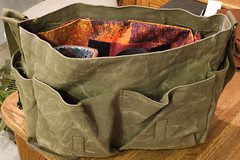
First of all the overall view of the finished product.
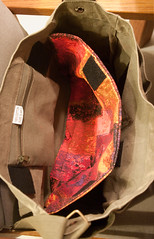
Here's the top view in "Laptop" configuration. It's got a piece of cloth sewn on both sides along the seam, made a bit longer to accommodate the laptop and it's extra padding in the left hand side. Note the small bits of stick on Velcro on the inside of the pocket, those'll come in handy in camera mode.

This is the laptop in it's padding. It's basically a three fold chunk of cloth with foam inserts in each section. It's not a perfect fit, but as it's stuffed into a cloth area so perfect fit doesn't matter that much.

Fully stuffed for work.
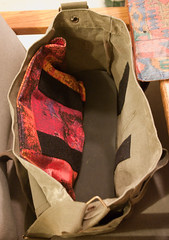
For when I want to put in a camera (the real purpose) I use the bits of Velcro (see above) to close the laptop area and now it's open with more stick on Velcro in a familiar looking configuration for anyone with a camera bag.

... which I use to stick in standard camera bag dividers stolen from another camera bag. It's not perfect, but it gives side padding and creates a familiar and usable triple section setup. There's a fair amount of adjustment in the center area, though it doesn't make it as snug as a "real" camera bag.
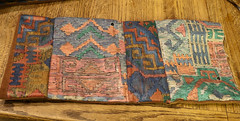
This is another bit of folded padding, this time a 4 fold section, each with it's own foam padding, and configured so it can be wrapped around something, say a longer zoom lens.
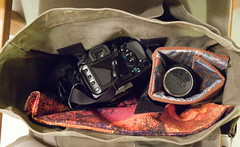
In full camera configuration. Note the zoom lens on the right wrapped up in the second chunk of padding and my beloved K20D sitting happily in the middle. Lots of room on the other side (and front pockets) for flash, more lenses, etc.
I've been using this bag as my full time work bag for a week or so now, and for one weekend of photowalking and here's what I've found so far:
Pros
- Sits nicely and comfortably across the shoulders. Much nicer than my laptop backpack as I don't have to have one hand on it for security (I tend to carry my backpack off of one shoulder only). Seems to stay comfortable for longer, even with laptop and workstuff in it.
- Easier (marginally) to get in and out of compared to my Lowe Pro bag, and way easier to get into than my "proper" camera backpack.
- Feels way more subtle carrying it around, and could potentially even be something to not alert people I'm a tourist on my next Mexican vacation (assuming my sunburnt or white skin doesn't of course).
- Flexible! Easy configuration changes with a small towel, tuque or t-shirt for padding.
- Lots of room for everything I've needed to lug around. Fits personal stuff (phone, wallet, etc) along with K20D with 16-45/4, Sigma 70-300, DA 40 Limited, walkaround P&S, batteries, spare memory cards, etc.
Cons
- There isn't a "top" handle so it's a bit odd to pick up the bag, I tend to grab it from the side and worry about it falling to the side and dumping everything out.
- The interior isn't perfectly padded compared to a real camera bag and I'm not sure how much I'd trust it to take a fall.
- The flap is a bit large, so the distance you have to go to get into the bag, and the amount of cloth you need to hold up if you're changing lenses is a bit much. Fairly easily mitigated though.
- The Velcro in the front isn't the most secure thing in the world. The option of a proper buckle that can be optionally clipped for longer trips might be nice.
- The Velcro really needs to be properly sewn in, the stick-on stuff isn't all that great.
- The colors are a bit.... uhm.... unexpected compared to the green of the canvas. Course, I'd have to be crazy to bitch about what my wonderful wife did set up for me!
Posted by Alan Bailward at 12:13 AM 0 comments
Thursday, January 22, 2009
1400+ Megapixel Inauguration Panorama
Not strictly Pentax related, in fact, our arch enemy Canon is involved here... regardless, check out this guy who made a 1,474 megapixel panorama from the presidential inauguration. It was done with the help of a Gigapan imager rig and had over 200 images stitched together.
Posted by Alan Bailward at 8:40 PM 0 comments
Friday, January 16, 2009
Searching For a Great Portrait Lens
A few days ago I suddenly got the feeling of "getting" the point of the fast zoom lens. The Canon and Nikon people have these great lenses that are 70-200mm/2.8 or thereabouts, and I never really got the thrill. Hey, I have a 70-300 macro that's just fine thanks, and it cost me $60 at a swap meet and it doesn't require an assistant to lug it around, what's the big deal... ?
Oh yea, the "f/2.8" part :)
So I got it in my head that a good or great portrait lens would be awesome to have, and being able to shoot shallow DoF portraits from distant(ish) distances was a new goal. Maybe this is what has been missing in my people photography? Course, having a budget I also tend to chant the following to myself:
Buying new gear will not make me a better photographer,
Buying new gear will not make me a better photographer.
But if I were....
Let me say that the site Pentax Photo Gallery is both brilliant and evil. Brilliant for giving a forum for Pentaxians to show off their (peer selected) work, and evil for allowing people such as myself to browse images by metadata and see a set of amazing images by a particular lens or camera.
So I have been looking at the following lenses:
- Pentax FA 77/1.8 Limited - by all accounts one of the best lenses from Pentax ever, full frame (for when Pentax releases a FF DSLR), but expensive and limited to one focal length (though it's a good length for portraits). PPG Images, BH info page, luminous landscape review.
- Pentax DA* 50-135/2.8 - Digital optimized, so not full frame, covering a nice set of distances (75-202mm in 35mm) for portraits, though I haven't heard much about it's quality (though I'm sure it's great). Also expensive. PPG Images, BH info page.
- Tamron 70-200mm/2.8 - I was surprised to hear that this came in a Pentax mount, and have seen and heard nothing more about it, other than seeing that it's also in the $700+ USD range. BH info page.
Course, there's also this little DA 10-17mm Fisheye zoom that I've been looking at... With pictures like this gorgeous one (and others if you click back and forth) that show none of the screaming "hey look, it's a fisheye!" look that you can get makes me think that could be a really fun lens to play with.
Posted by Alan Bailward at 11:57 PM 0 comments
Monday, January 12, 2009
Exposing To The Right in the K20D
Found this quick one through the DPReview forums.... Daystar Visions has an article with good tips for the K20D on how to do Expose To The Right and wrangling Shake Reduction. If you don't know what Expose To The Right (ETTR) is, you can catch up on it here.
Basically it's an idea that seems really simple at first, amounting to basically "make sure the majority of the stuff on the histogram is to the right instead of the left (but not over the edge, or "clipped" of course).
However, when you dwelve into it more, such as in the luminous landscape article, you see that the reason for this is the amount of information that's stored gets progressively larger the farther right on the histogram you get. It was only after looking through articles like this for ages that the meaning of "expose for the highlights, develop for the shadows" finally clicked in my brain. Sadly I still forget to do this in practice sometimes, and end up falling back to relying on autoexposure and clicking away :)
Another nice product for this is a set of videos on exposure and the Zone System called Perfect Exposure from PhotoCafe.
Posted by Alan Bailward at 9:39 AM 0 comments
Wednesday, January 7, 2009
New Toy! Quicky Panasonic LX3 Thoughts
So on boxing day I broke down and picked myself up a Canon G10 (you may have seen my angst regarding pocket cameras). It was quite nice and at the base ISO of 80 it produced nice images (at least on screen), had good physical controls, and so on. It didn't feel quite "right" to me though... it was a bit hard to describe, and I'm not sure if it was a bit too big, or the controls and menus weren't "new" enough, or maybe I'd just already made my mind up about getting an LX3 and I knew that I was just delaying the inevitable return of the G10.
After a lot of searching locally for a while (where apparently the LX3 simply isn't available for anywhere from a couple of weeks to a couple of months) I finally purchased one off of the B&H site.
Well, the 2-4 day shipping option I chose got it here in just 2 days and I spent last night playing with it, figured I'd let you know some initial thoughts.
First the bad (or not great):
- The size is a bit small for my hand... I liked the feel of the G10 in my hand, it felt hefty and solid. The shape of the LX3 makes it feel a tiny bit insecure while holding it, even with the nice rubber grip.
- I'd love more zoom (without compromising the lens of course).
- The buttons would be nice to be a tiny bit bigger. I'm sure this is just a learning thing though.
- This camera has a lot of features. I'm not sure if this is a bad thing or a good thing, or whether it's that Panasonic stuffed as many things in that little package that they could. Things like focus tracking, aspect ratio bracketing and a billion and one scene modes, custom functions, etc are great, as long as they don't a) clutter things up too much or b) detract from the quality of the software that does image processing, etc.
- More physical controls would be cool. The ability to map the custom function button to something (I have chosen ISO for now) is nice, but the G10 had a very nice setup on top with a mode dial (the green/Tv/Av/P/etc dial), ISO dial and EV dial. Another button that maps to a second custom function would be nice too.
On to the good!
- Nice and small. Not 100% jeans pocket sized, but very close (or baggy jeans sized).
- Lots of cool functions... see above. Discovering things like the focus tracking was fun.
- Advanced(ish) features like limiting auto-ISO and auto-shutter speed adjustments.
- The physical controls it does have are quite nice. The aspect ration selector and focus type selector in particular.
- The lens... Wide angle (24mm). Awesome. f/2.0-2.8. Yummy. Leica glass. Delicious.
- Menus and UI are also nicely laid out and visually are appealing... not a huge deal granted, and still nice to have.
- It seems that your custom settings (ie: set to shoot RAW or setting the program shift) are preserved from shot to shot. I think one thing that irked me about the G10 was you could set your aperture or shutter speed in program mode but it would reset back to baseline after you shoot.
- The quick menu seems potentially fairly awesome, allowing a fast change to a fair amount of settings. Will have to see how well this works in practice.
- I tend to shoot in program or Av mode, but it was interesting to see some of the preset scene modes they have, such as "film grain" which goes black and white and bumps the ISO up high to make the image grainy... looks very cool (at least on the screen).
I really look forward to getting out and using this bad-boy "for real" though and will be posting some images in the next few days. Now, back to your irregularily scheduled K20D talk!
Update: Note to self - need to get one of these: Ricoh lens cap on lx3.
Posted by Alan Bailward at 10:06 AM 1 comments
Sunday, January 4, 2009
JPG Archives Available
As you may or may not have heard, JPG Magazine is shutting down. Luckily they still have the archives available for download.
Posted by Alan Bailward at 5:16 PM 0 comments
Some Snowed In Reading
The weather here has still been insanely snowy (at least for the lower mainland) so here's some reading I've been doing the last while that might be of interest.
- Tackling a photo-a-day from pro-photo life, something I'm working on myself.
- Joe McNally has thoughts in the cold.
- Part 5 of the analysis of a wedding shoot. Fascinating to see how folks do it... start of the series is here.
- Genius of photography series, a six part series from the BBC on the 170 year history of photography.
- Making money as a travel photographer (points 9 and 10). Start of the series is here).
Posted by Alan Bailward at 12:06 AM 0 comments






